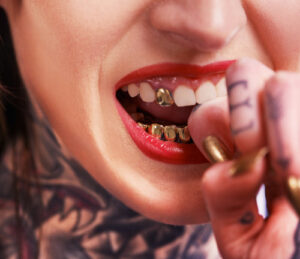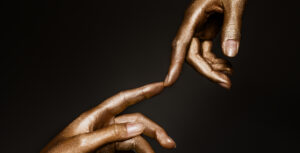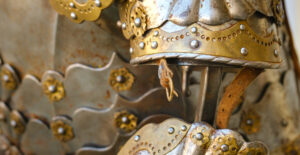
Walk down Bree Street in Johannesburg on any Friday night, and you’ll catch it, the flicker of gold between smiles. Not chains or rings this time. Teeth. Solid, shining grillz flashing under neon signs, behind dark sunglasses, in music videos filmed in parking garages. Once the calling card of American rappers and athletes, gold teeth have carved out a second life in South Africa, one rooted in kasi style, local hustle, and a street-level understanding of what wealth looks like when you can wear it.
Grillz aren’t new in global terms. The trend dates back decades in the United States, blending hip-hop bravado with jewellery craft. But in South Africa, especially in places like Durban’s CBD, Pretoria West, or the backstreets of Soweto, grillz have developed their own language and attitude. Here, they signal more than just flash. They are about resilience, about turning struggle into statement.
Unlike a Rolex or a fat gold chain, grillz are harder to spot unless you’re in conversation, up close. That’s part of the appeal. They’re personal, intimate, but still unmistakably loud. They say, I’ve made it, on my terms. You’ll find them worn by Gqom producers, amapiano vocalists, self-made influencers, and taxi bosses alike.
Behind this trend is a quiet industry few outside the scene really understand. Custom grillz shops now operate in Joburg and Cape Town, mixing formal jewellery-making with street culture. At a small workshop in downtown Durban, a craftsman named Musa sets up each morning with dental mould kits and rolls of 24-karat gold sheet. His clients range from university students to club owners.
“It’s not just about gold for gold’s sake,” Musa says. “You choose how many teeth. Top row, bottom row, full set. Some want diamonds, some want plain. It’s like telling your own story.” And like any serious accessory, it isn’t cheap. A single tooth cap in 10-karat gold can set you back R1,200. A full top and bottom row in solid 18-karat might cost anywhere between R10,000 and R25,000. Yet for many, the price is part of the appeal. If it were easy, everyone would have them.
Culturally, South Africa’s history with gold makes grillz feel inevitable. Gold has shaped the country’s economy for over a century. From the mines of Gauteng to the jewellery counters of Sandton, gold has always been about status, struggle, and survival. Turning that same gold into something you literally carry in your mouth? It’s both personal and political.
But there’s another layer too. For many kasi kids, grillz are about rewriting the rules of what “wealth” looks like. Traditional wealth might mean property or stocks, things many don’t yet have access to. But a mouthful of gold? That’s immediate, visible proof of hustle paying off. In townships where bank balances aren’t as public as clothes, cars, or teeth, grillz act as a walking bank statement.
Of course, not everyone loves the trend. Some older folks see it as a step too far, tacky, unnecessary, or linked too heavily with gangster culture. You’ll hear debates in salons and taxi ranks, is it fashion or is it flash gone wrong? But for those who wear them, those opinions don’t matter much. “You can’t tell me not to wear my own success,” says Thuli, a stylist from Umlazi with a six-tooth top row. “People said the same thing about gold chains in the ’80s.”
 There’s even a growing online scene around grillz in South Africa. Instagram accounts showcase custom work, from subtle single caps to full iced-out rows. Hashtags like #GoldTeethSA or #GrillzMzansi pop up alongside music and fashion content. And while the majority of pieces are made from real gold, there’s also a budget side, chrome or gold-plated options sold at flea markets for those still building up to the real deal.
There’s even a growing online scene around grillz in South Africa. Instagram accounts showcase custom work, from subtle single caps to full iced-out rows. Hashtags like #GoldTeethSA or #GrillzMzansi pop up alongside music and fashion content. And while the majority of pieces are made from real gold, there’s also a budget side, chrome or gold-plated options sold at flea markets for those still building up to the real deal.
The crossover into music culture has been especially sharp. Scroll through any new Gqom or amapiano music video, and you’re bound to catch grillz glinting behind the vocals. For younger fans, it’s not just a look. It’s aspirational. It’s proof that someone from their block can rise up, become a name, and wear gold like royalty.
Jewellers themselves are adapting. Shops that once specialised only in bangles and chains now offer custom grillz fittings, moulding kits, and design consultations. Some have gone as far as hosting pop-up events, “grillz days”, where customers can get moulded on the spot at a discount. It’s not quite as formal as dentistry, but the care taken with fitting and hygiene is real.
Perhaps what sets South Africa’s grillz culture apart most is its mix of grit and elegance. In some countries, grillz are purely about excess, bigger, flashier, more outrageous. But here, there’s a quiet pride in keeping things sharp but understated. A perfect line of gold on your front teeth. A subtle glint when you smile, just enough to catch the sun.
There’s also a growing conversation around legacy. Some wearers are choosing to pass their grillz down like family jewellery. When you outgrow a full set, instead of melting it down, you keep it. Frame it. Hand it off. It becomes part of the family’s gold archive alongside bangles and heirloom rings.
From a distance, it might just look like a fashion statement. But up close, grillz in South Africa are something more layered, a mix of history, economics, identity, and survival. They’re about taking something as ancient as gold and giving it a new life on the streets, where the real stories always start.



